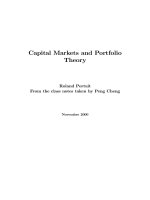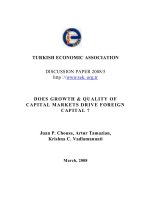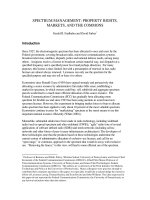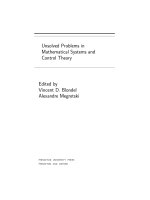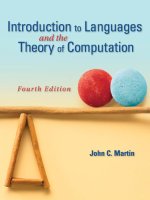Capital markets and portfolio theory (2000)
Bạn đang xem bản rút gọn của tài liệu. Xem và tải ngay bản đầy đủ của tài liệu tại đây (624.51 KB, 102 trang )
Capital Markets and Portfolio
Theory
Roland Portait
From the class notes taken by Peng Cheng
Novembre 2000
2
Table of Contents
Table of Contents
PART I Standard (One Period) Portfolio Theory ..................... 1
1 Portfolio Choices ........................................................ 2
1.A Framework and notations............................................. 2
1.A.i No Risk-free Asset
................................................ 2
1.A.ii With Risk-free Asset
.............................................. 4
1.B Efficient portfolio in absence of a risk-free asset ...................... 6
1.B.i Efficiency criteria
................................................. 6
1.B.ii Efficient portfolio and risk averse investors
........................... 8
1.B.iii Efficient set
...................................................... 9
1.B.iv Two funds separation (Black)
..................................... 10
1.C Efficient portfolio with a risk-free asset.............................. 11
1.D HARA preferences and Cass-Stiglitz 2 fund separation.............. 14
1.D.i HARA (Hyperbolic Absolute Risk Aversion)
........................ 14
1.D.ii Cass and Stiglitz separation
....................................... 15
2 Capital Market Equilibrium ..........................................17
2.A CAPM............................................................... 17
2.A.i The Model
..................................................... 17
2.A.ii Geometry
...................................................... 19
2.A.iii CAPM as a Pricing and Equilibrium Model
......................... 19
2.A.iv Testing the CAPM
.............................................. 21
2.B Factor Models and APT............................................. 21
2.B.i K-factor models
................................................. 21
2.B.ii APT
........................................................... 22
2.B.iii Arbitrage and Equilibrium
........................................ 24
2.B.iv References
...................................................... 25
PART II Multiperiod Capital Market Theory : the
Probabilistic Approach ........................................26
3Framework..............................................................27
3.A Probability Space and Information . . . . . . . . . . . . . . . . . . . . . . . . . . . . . . . . . . 27
3.B Asset Prices ......................................................... 28
3.B.i DeÞnitions and Notations
......................................... 28
3.C Portfolio Strategies .................................................. 29
3.C.i Notation:
....................................................... 29
3.C.ii Discrete Time
................................................... 29
3.C.iii Continuous Time
................................................ 30
i
Table of Contents
4 AoA, Attainability and Completeness...............................32
4.A DeÞnitions........................................................... 32
4.B Propositions on AoA and Completeness............................. 35
4.B.i Correspondance between Q and Π :MainResults
................... 35
4.B.ii Extensions
...................................................... 38
5 Alternative SpeciÞcations of Asset Prices ..........................39
5.A Ito Process .......................................................... 39
5.B Diffusions............................................................ 40
5.C Diffusion state variables ............................................. 41
5.D Theory in the Ito-Diffusion Case .................................... 41
5.D.i Framework
..................................................... 41
5.D.ii Martingales
..................................................... 42
5.D.iii Redundancy and Completeness
.................................... 42
5.D.iv Criteria for Recognizing a Complete Market
........................ 44
PART III State Variables Models: the PDE Approach................45
6Framework..............................................................46
7 Discounting Under Uncertainty ......................................48
7.A Ito’s lemma and the Dynkin Operator............................... 48
7.B The Feynman-Kac Theorem......................................... 48
8 The PDE Approach ...................................................50
8.A Continuous Time APT .............................................. 50
8.A.i Alternative decompositions of a return
............................. 50
8.A.ii The APT Model (continuous time version)
.......................... 51
8.B One Factor Interest Rate Models .................................... 53
8.C Discounting Under Uncertainty...................................... 53
9 Links Between Probabilistic and PDE Approaches ...............55
9.A Probability Changes and the Radon-Nikodym Derivative . . . . . . . . . . . 55
9.B Girsanov Theorem................................................... 56
9.C Risk Adjusted Drifts: Application of Girsanov Theorem ............ 56
PART IV The Numerai re Approach .....................................59
10 Introduction ............................................................60
11 Numeraire and Probability Changes ................................61
11.AFramework .......................................................... 61
11.A.i Assets
......................................................... 61
ii
Table of Contents
11.A.ii Numeraires
..................................................... 61
11.B Correspondence Between Numeraires and Martingale Probabilities . 62
11.B.i Numeraire → Martingale Probabilities
............................. 62
11.B.ii Probability → Numeraire
......................................... 63
11.CSummary ............................................................ 63
12 The Numeraire (Growth Optimal) Portfolio .......................65
12.A DeÞnition and Characterization ..................................... 65
12.A.i DeÞnition of the Numeraire (h
,H)
................................. 65
12.A.ii Characterization and Composition of (h
,H)
........................ 65
12.A.iii The Numeraire Portfolio and Radon-Nikodym Derivatives
............ 69
12.BFirst Applications ................................................... 69
12.B.i CAPM
......................................................... 70
12.B.ii Valuation
....................................................... 70
PART V Continuous Time Portfolio Optimization....................72
13 Dynamic Consumption and Portfolio Choices (The Merton
Model) ..................................................................73
13.AFramework .......................................................... 73
13.A.i The Capital Market
............................................. 73
13.A.ii The Investors (Consumers)’ Problem
............................... 74
13.BThe Solution......................................................... 74
13.B.i Sketch of the Method
............................................ 74
13.B.ii Optimal portfolios and L +2 funds separation
...................... 77
13.B.iii Intertemporal CAPM
............................................ 78
14 THE ”EQUIVALENT” STATIC PROBLEM (Cox-Huang,
Karatzas approach) ....................................................80
14.ATransforming the dynamic into a static problem .................... 80
14.A.i The pure portfolio problem
....................................... 80
14.A.ii The consumption-portfolio problem
................................ 82
14.BThe solution in the case of complete markets........................ 83
14.B.i Solution of the pure portfolio problem
............................. 83
14.B.ii Examples of speciÞc utility functions
............................... 85
14.B.iii Solution of the consumption-portfolio problem
...................... 86
14.B.iv General method for obtaining the optimal strategy x
∗∗
............... 87
14.C Equilibrium: the consumption based CAPM . . . . . . . . . . . . . . . . . . . . . . . . 88
PART VI STRATEGIC ASSET ALLOCATION .......................90
15 The problems ...........................................................91
16 The optimal terminal wealth in the CRRA, mean-variance
iii
Table of Contents
and HARA cases .......................................................92
16.A Optimal wealth and strong 2 fund separation....................... 92
16.B The minimum norm return ......................................... 92
17 Optimal dynamic strategies for HARA utilities in two cases ....93
17.A The GBM case...................................................... 93
17.B Vasicek stochastic rates with stock trading ......................... 93
18 Assessing the theoretical grounds of the popular advice .........94
18.AThe bond/stock allocation puzzle ................................... 94
18.BThe conventional wisdom............................................ 94
REFERENCES 95
iv
PART I
Standard (One Period)
Portfolio Theory
Chapter 1 Portfolio Choices
Chapter 1
Portfolio Choices
1.A Framework and notations
In all the following we consider a single period or time interval (0 1),hencetwo
instants t =0and t =1
Consider an asset whose price is S(t) (no dividends or dividends reinvested).
The return of this asset between two points in time (t =0, 1) is:
R =
S (1) − S (0)
S (0)
We now consider the case of a portfolio. and distinguish the case where a
riskless asset does not exist from the case where a risk free asset is traded.
1.A.i No Risk-free Asset
There are N tradable risky assets noted i =1, ..., N :
• The price of asset i is S
i
(t),t=0, 1.
• The return of asset i is
R
i
=
S
i
(1)− S
i
(0)
S
i
(0)
2
Chapter 1 Portfolio Choices
• The number of units of asset i in the portfolio is n
i
. The portfolio is described
by the vector n(t); n
i
can be >0(longposition)or<0 (short position).
• Then the value of the portfolio, denoted by X (t),is
X (t)=n
0
· S (t)
with n (0) = n (1) = n (no revision between 0 and 1), the prime denotes a
transpose. S (t) stands for the column vector (S
1
(t), ..., S
N
(t))
0
• The return of the portfolio is:
R
X
=
X (1) − X (0)
X (0)
• Portfolio X can also be deÞned by weights, i.e.
x
i
(0) = x
i
=
n
i
S (0)
X (0)
(Note that x
i
(1) 6= x
i
). Besides the weights sum up to one:
x
0
· 1=1
where x=(x
1
,x
2
, ..., x
N
)
0
and 1 is the unit vector.
• The return of the portfolio is the weighted average of the returns of its
components:
R
X
= x
0
R
3
Chapter 1 Portfolio Choices
Proof
1 + R
X
=
X (1)
X (0)
=
n
0
S (1)
X (0)
=
N
X
i=1
n
i
S
i
(1)
X (0)
·
S
i
(0)
S
i
(0)
=
N
X
i=1
x
i
·
S
i
(1)
S
i
(0)
=
N
X
i=1
x
i
· (1 + R
i
)
= 1 +
N
X
i=1
x
i
R
i
Q.E.D.
• DeÞne µ
i
= E [R
i
] and µ=(µ
1
,µ
2
, ..., µ
N
)
0
, then:
µ
X
= E (R
X
)=x
0
µ
• Denote the variance-covariance matrix of returns Γ
N×N
=(σ
ij
),where
σ
ij
= cov (R
i
,R
j
),then:
var (R
X
)=var (x
0
R)
= x
0
Γx
=
N
X
i=1
N
X
j=1
x
i
x
j
σ
ij
1.A.ii With Risk-free Asset
We now have N +1 assets, with asset 0 being the risk-free asset, and the remaining
N assets being the risky assets.
4
Chapter 1 Portfolio Choices
• S
0
(1) = S
0
(0) · (1 + r) with r a deterministic interest rate.
• Again we can deÞne the portfolio in units, with n=(n
0
,n
1
,n
2
, ..., n
N
)
0
• The portfolio can be similarly deÞned in weights:
x
i
=
n
i
S (0)
X (0)
for the N risky assets (i =1, 2,...,N),and
x
0
=1−
N
X
i=1
x
i
Note that now
x
0
· 1 6=1
where x=(x
1
,x
2
, ..., x
N
)
0
denotes the weights in the N risky assets.
• The return of the portfolio is:
R
X
= x
0
r +
N
X
i=1
x
i
R
i
= r +
N
X
i=1
x
i
(R
i
− r)
The term (R
i
− r) is the excess return of asset i over r.Moreover:
µ
X
= E (R
X
)=r + x
0
π
where π is the risk premium vector of the E (R
i
− r)
• Also denote Γ
N×N
as the variance-covariance matrix of the risky assets, then:
var (R
X
)=x
0
Γx
Γ is always positive semi-deÞnite (meaning that ∀x, x
0
Γx ≥ 0).Insomecases
it is positive deÞnite (∀x 6=0, x
0
Γx > 0).
DeÞnition 1
Assets i = 1, 2, ..., N are redundant if there exist N scalars λ
1
, λ
2
, ..., λ
N
such
that
P
N
i=1
λ
i
R
i
= k,wherek is a constant. Then the portfolio λ
is risk-free.
Proposition 1
The N assets i = 1, 2, ..., N are not redundant iff Γ is positive deÞnite (i.e. non-
singular or invertible).
5
Chapter 1 Portfolio Choices
Proof
Assume that the assets are redundant, then there exist N scalars λ
1
, λ
2
, ..., λ
N
such that
P
N
i=1
λ
i
R
i
= k. Consider the portfolio deÞned by the weights λ
. The variance of its return =
var (k)=0=λ
0
Γλ
,i.e. Γ is singular and not positive deÞnite. Conversely if Γ is singular
and not positive deÞnitethereexistanon0vectorλ
such that λ
0
Γλ =0; Then the return of
portfolio λ
has zero variance and
P
N
i=1
λ
i
R
i
= k
Q.E.D.
Remark 1
In the following sections we will assume that the assets are non-redundant (it is
always possible to “drop” redundant assets if any).
1.B Efficient portfolio in absence of a risk-free asset
1.B.i Efficiency criteria
DeÞnition 2
Portfolio (x
∗
,X
∗
) is efficient if ∀y
, σ
Y
< σ
X
∗
⇒ µ
Y
<µ
X
∗
and σ
Y
=
σ
X
∗
⇒ µ
Y
≤ µ
X
∗
Consider any efficient portfolio (x
∗
,X
∗
) and let variance(R
X
)=k
x
∗
solves the optimization program (P ):
max
x
E [R
X
] s.t. x
0
Γx = k ; x
0
1 =1
The Lagrangian is:
L
µ
x,
θ
2
, λ
¶
= x
0
µ−
θ
2
x
0
Γx− λx
0
1
The Þrst order condition
¡
∂L
∂x
=0
¢
writes:
µ− θΓx
∗
−λ1 =0
or equivalently, for i =1, .., N :
µ
i
= λ + θ
N
X
j=1
x
∗
j
σ
ij
6
Chapter 1 Portfolio Choices
Remark that these Þrst order conditions are necessary and also sufficient for the
solution being a maximum since the second order conditions hold (L(x) is strictly
concave -Γ positive deÞnite).
Theorem 1
A portfolio (x
,X) is efficient iff there exist two scalars λ and θ such that for all
i = 1, 2, ..., N :
µ
i
= λ + θ · cov (R
x
,R
i
)
Proof
The necessary and sufficient condition for x to be efficientisthatitsatisÞes the Þrst order
condition: for all i: µ
i
= λ + θ
P
N
j=1
x
∗
j
σ
ij
. We then have:
µ
i
= λ + θ
N
X
j=1
x
∗
j
cov (R
i
,R
j
)
= λ + θ · cov
R
i,
N
X
j=1
x
∗
j
R
j
= λ + θcov (R
i
,R
X
)
Q.E.D.
Remark 2
The second term can be considered as the additional required rate of return (risk
premium), proportional to cov (R
i
,R
X
).
Remark 3
If cov (R
i
,R
X
)=0,thenµ
i
= λ.
Remark 4
Also note:
var (R
X
)=
N
X
i=1
N
X
j=1
x
i
x
j
σ
ij
=
N
X
i=1
x
i
· cov
R
i
,
N
X
j=1
x
j
R
j
=
N
X
i=1
x
i
· cov (R
i
,R
X
)
Thecovariancetermcov (R
i
,R
X
) indicates the contribution of asset i to the total risk of the
portfolio. Therefore, additional required rate of return should be proportional to this induced risk
which is what is stated in the theorem. Moreover cov (R
i
,R
X
) appears to be the relevant measure
of risk for any asset i embedded in the portfolio X.
7
Chapter 1 Portfolio Choices
1.B.ii Efficient portfolio and risk averse investors
DeÞne another optimization program (P
0
), equivalent to (P ) :
(P
0
)max
µ
x
0
µ−
θ
2
x
0
Γx
¶
s.t. : x
0
1 = 1
( (P ) and (P
0
) yield the same solutions since they have the same Lagrangian)
(P
0
) writes, equivalently:
Max E[R
X
]−
θ
2
var (R
X
) , s.t. : x
0
1 = 1
In (P
0
) θ is interpreted as a given risk-aversion while in (P ) it is an unknown
lagrangian multiplier.
In (P ) we are given σ
2
X
and we solve for θ and λ as functions of σ
2
X
.In(P
0
) we
aregiventherisk-aversion parameterθ and solve for σ
2
X
as function of θ.
The Þrst order conditions of (P’) write as for (P): µ − θΓx
∗
−λ1 =0(with only
one multiplier for (P
0
))
• Consider the case of minimum variance portfolio where θ = ∞, i.e.
min
1
2
x
0
Γx s.t. : x
0
1 =1
The Lagrangian is then:
L (x,λ)=
1
2
x
0
Γx− λx
0
1
Call k
1
the solution. The Þrst order condition gives:
Γk
1
− λ1 =0
Together with the constraint k
0
1
1 =1gives:
λ =
1
1
0
Γ
−1
1
Thus:
k
1
= λΓ
−1
1
=
1
1
0
Γ
−1
1
· Γ
−1
1
8
Chapter 1 Portfolio Choices
1.B.iii Efficient set
DeÞnition 3
The Efficient Set is the set of all x
∗
that obey the Þrst order condition. Equiv-
alently, it is the set of all x
∗
that solve the optimization program (P
0
) ∀θ ≥ 0.
Recall that the Þrst order condition for (P
0
) is:
µ− θΓx
∗
−λ1 =0
DeÞne risk tolerance
b
θ as the inverse of risk aversion, i.e.
b
θ =
1
θ
Then x
∗
can be solved as:
x
∗
=
b
θΓ
−1
¡
µ− λ1
¢
To Þnd λ,usetheconstraint1
0
x
∗
=1,i.e.
1=1
0
x
∗
= 1
0
·
b
θΓ
−1
¡
µ− λ1
¢
Then:
b
θ1
0
Γ
−1
µ−
b
θλ1
0
Γ
−1
1 =1
or:
b
θ1
0
Γ
−1
µ−
b
θλ1
0
Γ
−1
1 =
b
θθ
This solves for λ:
λ =
1
0
Γ
−1
µ−θ
1
0
Γ
−1
1
Then:
x
∗
=
b
θΓ
−1
¡
µ − λ1
¢
=
b
θΓ
−1
µ
µ −
1
0
Γ
−1
µ − θ
1
0
Γ
−1
1
·1
¶
=
Γ
−1
1
1
0
Γ
−1
1
+
b
θΓ
−1
µ
µ−
1
0
Γ
−1
µ
1
0
Γ
−1
1
·1
¶
9
Chapter 1 Portfolio Choices
We recognize in the Þrst term the minimum variance portfolio (k
1
)andwecall
k
2
the second term:
k
1
=
Γ
−1
1
1
0
Γ
−1
1
k
2
= Γ
−1
·
µ −
1
0
Γ
−1
µ
1
0
Γ
−1
1
·1
¸
Then the solution of (P ) writes:
x
∗
= k
1
+
b
θk
2
Note that k
0
1
1 =1and x
∗0
1 =1,thereforek
0
2
1 =0.Anyefficient portfolio is thus
the sum of k
1
(the minimum variance portfolio) and k
2
which is a zero weight
(zero investment) portfolio. As it could be expected, an investor with a zero risk
tolerance will hold only k
1
; If he has a positive risk tolerance
b
θ he will add a risk
taking the form
b
θk
2
in order to increase the expected return. The efficient set can
now be caracterized as:
ES =
n
x
∗
|x
∗
= k
1
+
b
θk
2
∀
b
θ > 0
o
Since the expected return x
∗0
µ is linear in
b
θ and the variance is quadratic in
b
θ,in
the (σ
2
,R) space the efficient portfolios are represented by the efficient frontier,
which is a parabola. Each point on the efficient frontier corresponds to a given θ,
the slope of the parabola at this point being equal to
θ
2
(the shadow price in (P )
of the constraint on variance).
In the (σ,R) space the efficient frontier is an hyperbola.
1.B.iv Two funds separation (Black)
Theorem 2
Consider any two efficient portfolio x and y:
1. Any convex combination of x and y is efficient, i.e.∀ u ∈ [0, 1] ,ux+(1− u) y ∈
ES
2. Any efficient portfolio is a combination of x and y (not necessarily a convex
combination)
3. The whole parabola (efficient and inefficient frontier) is generated by (all)
combinations of x and y
10
Chapter 1 Portfolio Choices
Proof
• Since x∈ ES and y∈ ES, for some positive
b
θ
X
and
b
θ
Y
,wehave:
x = k
1
+
b
θ
X
k
2
y = k
1
+
b
θ
Y
k
2
Let z = ux +(1− u)y, then:
z =[uk
1
+(1− u) k
1
]+
h
u
b
θ
X
+(1− u)
b
θ
Y
i
k
2
= k
1
+
b
θ
Z
k
2
With
b
θ
Z
> 0, we can conclude that z∈ ES.
• Let z∈ ES,thenz = k
1
+
b
θ
Z
k
2
for some
b
θ
Z
> 0. For any x∈ ES and
y∈ ES:
ux +(1− u) y = k
1
+
h
u
b
θ
X
+(1− u)
b
θ
Y
i
k
2
By equating
b
θ
Z
to u
b
θ
X
+(1− u)
b
θ
Y
we get:
u
∗
=
b
θ
Z
−
b
θ
Y
b
θ
X
−
b
θ
Y
Then the combination u
∗
x +(1− u
∗
) y = z
Q.E.D.
1.C Efficient portfolio with a risk-free asset
Consider Þgure 1 where the upper branch of the hyperbola EFR represents, in the
(σ,E) space, the efficient portfolios in absence of a riskless asset. Assume now that
exists a risk free asset 0 yielding the certain return r. M stands for the tangency
point of the hyperbola EFR with a straight line drown from r representing asset 0.
Point M represents a portfolio composed only of risky assets, called the tangent
portfolio.
11
Chapter 1 Portfolio Choices
• Efficient frontier in presence of a riskless asset
σ
E
r
M
X
EFR
Figure 1.1.
12
Chapter 1 Portfolio Choices
Proposition 2
1. Asset 0 is efficient
2. Consider any portfolio X. Any combination of 0 and X yielding
R = uR
X
+(1− u) r, lies on the straight line connecting 0 and X in the (σ,E)
space
3. Any feasible portfolio which representative point is not on r − M (such as X)
is dominated by portfolios in r − M. The straight line r − M is the efficient
frontier and is called the Capital Market Line
4. (Tobin’s Two-fund Separation) Any efficient portfolio is a combination of any
two efficient portfolios, for instance 0 and M
5. Any efficient portfolio writes:
x
∗
=
b
θΓ
−1
¡
µ−r1
¢
6. The tangent portfolio (m,M) is:
m =
b
θ
M
Γ
−1
¡
µ−r1
¢
b
θ
M
=
1
1
0
Γ
−1
¡
µ−r1
¢
Proof
1, 2, 3, 4 are standard and easy to prove. Let us proove 5 and 6: x
∗
∈ ES solves:
max
1
r + x
∗0
¡
µ
− r1
¢
−
θ
2
x
∗0
Γx
∗
The Þrst order condition is:
µ
− r1
= θΓx
∗
Then:
x
∗
=
1
θ
Γ
−1
¡
µ
− r1
¢
=
b
θΓ
−1
¡
µ
− r1
¢
The tangent portfolio is an efficient portfolio, therefore, m
=
b
θ
M
Γ
−1
¡
µ
− r1
¢
.Also:m
0
1 = 1,
then:
b
θ
M
=
1
1
0
Γ
−1
¡
µ
− r1
¢
Q.E.D.
13
Chapter 1 Portfolio Choices
Remark 5
Given a risk tolerance
b
θ:
•
b
θ <
b
θ
M
, the portfolio is long in 0 and m
•
b
θ >
b
θ
M
, the portfolio shorts 0
Remark 6
We deÞne later the market portfolio as a portfolio containing all the risky assets
present in the market (and only risky assets). In absence of riskless asset the market portfolio is
efficient iif its representative point belongs to the hyperbola EFR. In presence of a risk free asset
the necessary and sufficient condition for the market portfolio to be efficientisthatitcoincides
with the tangent portfolio m
(which is the only efficient portfolio of EFR, in presence of a risk
free asset). Would all investors face the same efficient frontier (it would be the case under
homogeneous expectations and horizon) and would they all follow the mean-variance criteria,
they would all hold combinations of 0 and M and the tangent portfolio M would necessarily
coincide with the market portfolio.
1.D HARA preferences and Cass-Stiglitz 2 fund separation
A rational agent (in the sense of Von Neumann-Morgenstern) should maximize
the expected utility of wealth E [U (W)].
1.D.i HARA (Hyperbolic Absolute Risk Aversion)
A utility function U (W ) belongs to HARA class if it writes:
U (W )=
γ
1 − γ
·
b
θ +
W
γ
¸
1−γ
Some restrictions are imposed on the coefficients γ and
b
θ and the domain of
deÞnition.
The absolute risk tolerance (ART) and absolute risk aversion (ARA) are:
ART =
1
ARA
= −
U
0
U
00
=
b
θ +
W
γ
14
Chapter 1 Portfolio Choices
and the relative risk tolerance (RRT) is:
RRT =
b
θ
W
+
1
γ
In particular:
1.
b
θ =0⇒
U (W )=
W
1−γ
1 − γ
We obtain CRRA, i.e. constant relative risk aversion.
A limit case of CRRA is obtained for γ =1which can be showed to be
equivalent to the Log utility
2. γ = −1 ⇒
U (W )=W −
W
2
2
b
θ
i.e. the quadratic utility function.
3. Using a quadratic utility function implies a mean-variance criteria; Indeed:
min var (R
X
) s.t. E [R
X
]=
b
E (and x
0
1 =1)
⇔ min E [R
2
X
] s.t. E [R
X
]=
b
E (and x
0
1 =1)
⇔ min E [X
2
(1)] s.t. E [X (1)] = X (0) ·
h
1+
b
E
i
⇔ min E[X
2
(1)] − λE [X (1)]
⇔ max E
£
X (1) −
1
λ
X
2
(1)
¤
4. Three undesirable features of the quadratic utility:
—
Saturation at W =
b
θ (for that wealth U (W )=W −
W
2
2
b
θ
is maximum; U (W) decreases
for W>
b
θ!)
—
ARA increasing with wealth (it is commonly admitted that ARA decreases for most
agents).
—
Indifference to skewness (only the two Þrst moments of W matter), whereas most
investors actually like skewness.
1.D.ii Cass and Stiglitz separation
Cass and Stiglitz showed that all HARA investors sharing the same exponential
15
Chapter 1 Portfolio Choices
parameter γ can build their optimal portfolios by mixing the two same funds.
When a risk free asset exists it can be chosen as one of the two funds. Since all
quadratic (mean-variance) investors exhibit the same γ(= −1) Tobin and Black
2 fund separation are particular cases of Cass and Stiglitz separation. Cass and
Stiglitz conditions on the utility functions for separation to hold for investors
sharing the same exponential parameter are summarized in the following table
Complete Market Incomplete Market
@r (under complete markets ∃ r) quadratic or CRRA
2
∃ r class wider than HARA HARA
2
in the particular case of CRRA one fund suffices (for a given
γ
the portfolio is the same for all W
16
Chapter 2 Capital Market Equilibrium
Chapter 2
Capital Market Equilibrium
2.A CAPM
2.A.i The Model
Consider again N risky assets (a risk free asset may exist or not). The market
value of asset i is V
i
, then (by deÞnition of the market portfolio) it’s weight in the
market portfolio is:
m
i
=
V
i
P
N
i=1
V
i
The return of the market portfolio is:
R
M
= m
0
R
Hypothesis 1
(H):The market portfolio M is efficient.
Remark 7
The market portfolio would be efficient if all investors would hold efficient port-
folios (since a combination of efficient portfolios is efficient).
Theorem 3
(General CAPM )
1. If (H) is true, then there exist θ and λ such that, for i =1, ..., N :
µ
i
= E [R
i
]
= λ + θcov (R
M
,R
i
)
2. Conversely, if there exist θ and λ such that, for i =1, ..., N : µ
i
=
λ + θcov (R
M
,R
i
),then(H) is true.
17
Chapter 2 Capital Market Equilibrium
Proof
The proof comes directly from Theorem 1.
Q.E.D.
Remark 8
θ can be interpreted as the risk aversion of the average (representative) investor.
Remark 9
CAPM holds for any portfolio (x
,X).
Indeed, call R
X
its return and consider the case where no risk free asset exists
(x
0
1 =1):
E [R
X
]=
N
X
i=1
x
i
µ
i
=
N
X
i=1
x
i
(λ + θcov (R
M
,R
i
))
=
N
X
i=1
x
i
λ + θ
N
X
i=1
x
i
cov (R
M
,R
i
)
= λ + θcov
Ã
R
M
,
N
X
i=1
x
i
R
i
!
= λ + θcov (R
M
,R
X
)
Remark 10
The proof follows the same lines when the portfolio contains a risk free asset
with weight x
0
Remark 11
λ and θ are the same for all assets or portfolios
Remark 12
For the market portfolio:
µ
M
= λ + θcov (R
M
,R
M
)
= λ + θσ
2
M
Therefore:
θ =
µ
M
− λ
σ
2
M
Then:
µ
i
= λ + θcov (R
M
,R
i
)
= λ +
·
µ
M
− λ
σ
2
M
¸
cov (R
M
,R
i
)
18
Chapter 2 Capital Market Equilibrium
DeÞne:
β
i
=
cov (R
M
,R
i
)
σ
2
M
Then we may write the CAPM equation in the alternative form:
E [R
i
]=λ + β
i
(µ
M
− λ)
Consider any portfolio z with β
Z
=0:
β
Z
=0
⇔ cov (R
M
,R
Z
)=0
⇔ cov (m
0
R, z
0
R)=z
0
Γm =0
⇐⇒ z ⊥Γm
⇔ z ∈ [vect (Γm)]
⊥
vect[v
1
, v
2
, ..., v
N
] is the set of all linear combinations of v
1
, v
2
, ..., v
N
, or linear
subspace generated by v
1
, v
2
, ..., v
N
. The dimension of [vect (Γm)]
⊥
is thus N − 1
and there are an inÞnity of 0-beta portfolios. Now, from the general CAPM, we
would have: λ = µ
Z
;Thus:
Corollary 1
(0−beta CAPM) If M is efficient, for any zero beta portfolio or asset Z: E [R
i
]=
µ
Z
+ β
i
(µ
M
− µ
Z
)
Corollary 2
(Standard CAPM):If there exists a risk-free asset yielding r (which is a par-
ticular zero beta asset)
E [R
i
]=r + β
i
(µ
M
− r)
Note that µ
Z
= r for any zero beta portfolio or asset.
2.A.ii Geometry
missing
2.A.iii CAPM as a Pricing and Equilibrium Model
• For a security delivering
e
V (1) at time 1(the pdf of
e
V (1) is given, thus
E(
e
V (1)) and cov(
e
V (1) ,R
M
) are known), what is its price V (0) at time 0?
19



